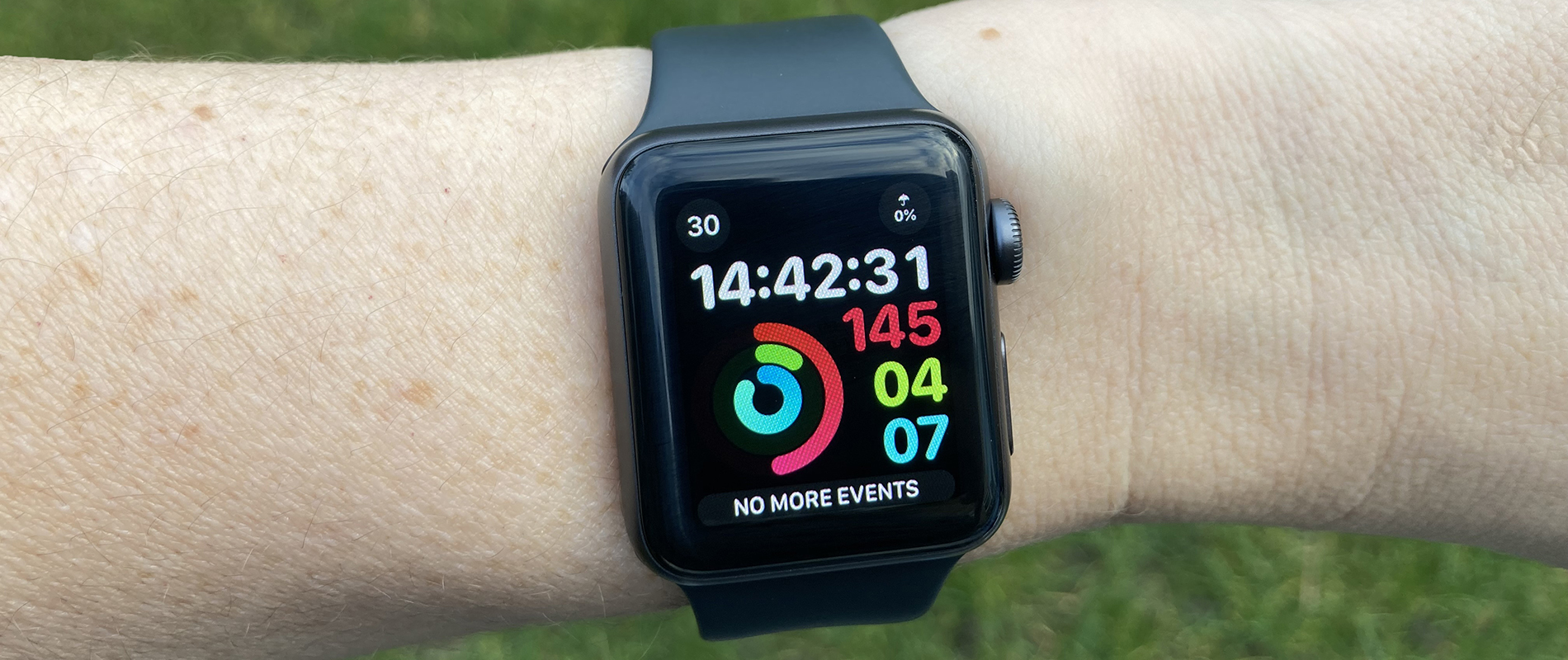Fitness watches – an accessibility review
This one goes out to anyone making good on their New Year resolution to get fitter… Whether you're doing couch to 5K, braving the gym, or increasing your step count, you might be wondering if a fitness watch will help you meet your goals.
We make no such promises here – you've still got to get out of breath! (Personally, I'm a convert. Before lockdown I thought the Apple Watch was just another way to separate Apple fanboys from their money – now I credit mine with improved fitness and a significantly looser waistband.) What we can do is make it easier for you to compare the accessibility functions of watches you might be looking at, so you can make an informed choice…
We've found one fitness watch and three smartwatches that have enough accessibility to make them usable with sight loss. We'll be focussing on accessibility features (and gaps) rather than covering all the features and functions of each product. Researcher Charlee Jarvis offers the assurance that "none of the watches below looks like an 'accessible' watch – big and bulky", and all of them can be personalised by choosing different case colours and straps. For an in-depth look at each product, including its fitness features, please follow the links provided.
Before we get into specifics, let's start with some generalities. Dave Williams, a blind marathon runner, is an experienced hand in this field and has plenty of advice for those looking to buy their first fitness watch or smart watch.
First, it's helpful to know whether you should be looking at a fitness watch or smartwatch. If you need a screen reader or a magnifier, then a smartwatch will probably be a better fit than a fitness watch.
Of course, smartwatches, like the Apple Watch, Galaxy Watch, or Pixel Watch offer a wide range of apps for messaging, media, reminders, calendar, contacts etc, while dedicated fitness watches such as Garmin, and FitBit, are mainly focused on counting steps, recording workouts, and keeping you active and do not offer the same wide range of third-party apps. This manifests itself in the pricing of these products – smartwatches tend to be more expensive than most fitness watches. However, fitness watches often offer longer battery life and more choice in terms of size and over-all design.
Dave says, "Smartwatches tend to have a more rounded set of accessibility features including a full screen reader and screen magnifier that make all built-in apps and many third-party apps fully accessible for blind and partially sighted people. Whereas the fitness watches usually have a much more limited set of accessibility features that may speak and enlarge some key functions, but do not provide sufficient accessibility to completely and independently control the device.
"If you do decide a smartwatch is the way to go, your choice may be determined by your existing smartphone. For example, Apple Watch is designed to work closely with iPhone, and you may need your iPhone for setup and installing software updates. Fitness watches tend to be a bit more platform agnostic, having their own companion apps which work with iOS or Android."
He adds, "I’ve been using Apple Watch for running metrics for about five years. I wouldn’t be without it now for all sorts of reasons. I use it for tracking physical activity, heart rate, weather, daylight, appointments, buying products and services with Apple Pay and even identifying songs on the radio."
If you don't need a screenreader, Dave recommends looking at fitness watches in person before you buy so you can get a good idea of screen brightness, text size, etc. It can also be worth buying your smartwatch in store so that it can be set up for you before you leave. If that's not feasible, then RNIB's Technology for Life team may be able to offer support over the phone to help you get started.
As always, we recommend shopping around for the best price – for example, you can save money on the Apple Watch by opting for a smaller case, an earlier version (for example, the Apple Watch SE), or a refurbished watch (available from around £209).
Jo Franks, editor
Fitbit Versa 4
The only 'pure' fitness watch in our list comes with more accessibility than you might expect – although, like the smartwatches below, you'll need a smartphone to get the most out of some features.
The Versa 4 works with the FitBraille app to translate the time and your current step count to braille, and then uses vibrations to represent each number.
You can also pair the Versa 4 with an Amazon Alexa and use the voice assistant to read your steps, resting heart rate, sleep score, and many other stats out loud.
There is Google accessibility support available to answer questions about your Fitbit device by phone, chat, email, the Be My Eyes app, and video with ALS specialists.
You can use pre-set hand gestures to access frequently used apps, and quick-press side buttons to activate contactless payment. Brightness is adjustable and you can have the voice assistant come through the watch speakers or headphones.
Features include: heart rate tracker and notifications for high / low rate, pedometer, blood oxygen tracker, skin temperature tracker, and access to texts, emails, and calls.
The disadvantages of the Versa 4 are that although this watch is on the cheaper end of the scale, the size of the screen is only 1.5 inches, so would only really be suitable if using the voice assist features. It's also a lot more geared towards the fitness tracking side of things. The apps are accessible, but the watch isn't as accessible as it could be. (Feedback from customers via RNIB Connect Voices is that they think the compatible apps are great, but the watch itself isn’t suitable for users without sight.)
Fitbit Versa 4, £149.99, Fitbit.
Samsung Galaxy Watch 6, 44mm
This smartwatch from Samsung offers sharp contrast fonts (you can change all fonts to white, including menus); colour correction (colour filters can be changed to suit your needs, for example, greyscale); colour inversion; the ability to remove some screen effects if your eyes are sensitive to animation; and the ability to reduce visual effects, like transparency and blur, on dialogues and menus.
You can adjust text size and also magnify the screen – triple tap the screen to zoom in and out and pinch to adjust the zoom. To pan out, turn the bezel or drag two fingers.
This smartwatch also works with the TalkBack screenreader and has a 1.47-inch screen (44mm version.)
Features include: pedometer, heart rate monitor, calorie counter, blood pressure monitor, and ECG.
The disadvantages of this product are the higher price point (which does not reflect the limited features some customers would use) and that it has a lot of additional features which may overcomplicate things for someone looking for a basic talking fitness watch.
Samsung Galaxy Watch 6, 44mm, £249.00, Amazon.
Google Pixel Watch 2, GPS 41mm
The Pixel Watch 2 incorporates all the features of a Fitbit but with a larger screen size. Customisable watch faces mean you can choose the size/style/colour that suits you and the light, 100 per cent recycled aluminium housing makes the watch comfortable to wear – it won't weigh you down when using a cane or guide dog.
It's compatible with Google Assistant, so you can control your connected home, set timers, and get your Fitbit stats, like activity and sleep, right on your watch. Just say 'Hey Google' to activate.
You can increase font size and use the TalkBack screenreader, and if you buy instore, you can get assistance setting up accessibility.
Features include: sensors for advanced heart rate tracking, skin temperature tracking and stress management; customisable widgets so you can have information at a glance; contactless payments via Google Wallet, turn-by-turn directions through the maps app; safety features such as Fall Detection, Safety Check and Emergency SOS; send and receive texts/emails; make calls via Bluetooth when connected to a compatible device.
Up to 24 hours' battery life from a single charge and can connect to smart speakers.
The disadvantages of this product are, again, the higher price point (which does not reflect the limited features some customers would use) and that it has a lot of additional features which may overcomplicate things for someone looking for a basic talking fitness watch. It is also not available in the 44mm size, like Apple/Samsung watches.
Google Pixel Watch 2, GPS 41mm, £349, John Lewis.
Apple Watch Series 9 GPS 45mm (sport band)
The 1.7-inch screen of the 45mm Series 9 Apple Watch has customisable watch faces that can be made bigger. You can also change the colours of the faces and change from analogue to digital if cannot see an analogue face. It also has advanced brightness which boosts the maximum brightness up to 2,000 nits, so it is easier to read in full sun.
The smartwatch works with VoiceOver and can be voice activated; it also works with Siri to complete basic commands – activate Apple's assistant with "Hey, Siri". You can also use hand gestures to carry out some commands – the double tap feature (tapping thumb and index finger together) can answer calls, open a notification, and play and pause music.
Other accessibility features include large text; the triple taps zoom function which makes everything on the screen bigger; increase contrast; reduce transparency; bold text; colour filters (used to differentiate between colours for blind users); and haptic feedback (the watch will vibrate when notifications are received, vibrates while walking map instructions are activated to let you know when a turning is coming up, and can tell you about the time through vibrations if you do not want to use VoiceOver in public).
Features include: tracking blood oxygen levels, ECG, and heart rate; crash detection (connects you with emergency services, provides dispatchers with your location, and notifies emergency contacts); enabled for contactless payments; Emergency SOS – call emergency services and notify your emergency contacts without dialling the number. The Apple Watch is also durable (dust and crack-resistant).
The disadvantages of this product are, again, the higher price point (which does not reflect the limited features some customers would use) and that it has a lot of additional features which may overcomplicate things for someone looking for a basic talking fitness watch.
Apple Watch Series 9 GPS 45mm (sport band), £429.00, John Lewis.

